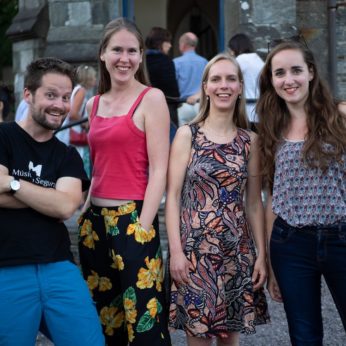Composer: Joseph Haydn (b. 1732 - d. 1809)
Performance date: 03/07/2018
Venue: St. Brendan’s Church
Composition Year: 1732 - 1809
Duration: 00:23:30
Recording Engineer: Ciaran Cullen, RTÉ
Instrumentation: T-solo, pf
Instrumentation Category:String Quartet
Artists:
Dudok Quartet Amsterdam Judith van Driel [violin], Marleen Wester [violin], Marie-Louise de Jong [viola], David Faber [cello]) -
[quartet]

37. MAIN EVENING CONCERT – ST BRENDAN’S CHURCH 20.00
Dudok Quartet Amsterdam
Judith van Driel, Marleen Wester [violins]
Marie-Louise de Jong [viola]
David Faber [cello]
Joseph Haydn [1732-1809]
String Quartet in F minor Op.20/5
1. Moderato
2. Minuet and Trio
3. Adagio
4. Finale; fuga a due soggetti
Haydn’s six Op.20 Quartets were written in 1772 during Haydn’s sturm und drang (storm and stress) period. Sturm and drang was a literary and musical movement which anticipated nineteenth century Romanticism. It emphasised a return to nature, the importance of individual emotions particularly when they were passionate and, if the weather became involved, it would of course be stormy.
Sturm and drang allowed him to compose symphonies and quartets which were much more serious than ever before. He used more dynamic contrasts with long crescendos as well as sudden outbursts of loud music. His compositions, no longer intended as simply diversions for a court, became much more emotional and much less frivolous. To emphasize the seriousness of these Op.20 Quartets Haydn includes two in the minor key instead of the usual one. Of all the six quartets, the one in F minor is probably the most emotional.
The first movement is in sonata form and opens with a mournful melody which dominates the movement. The second main theme, which is introduced by a semi quaver passage on the cello, is in a major key. Its dotted rhythms make for a sunnier mood, but it plays little part in the rest of the movement. The return to the recapitulation is marked by three downward triplets on the first violin. The main theme is further developed in a passage of considerable emotional turmoil. After repeating the whole movement in two parts, Haydn adds a harmonically adventurous coda which briefly develops the second main theme before a subdued conclusion. The Minuet, also in F minor, manages to be both sad and elegant. The playful Trio brings a brief moment of warmth and charm.
The slow movement is a dance. It has been called a Siciliana and for most of the movement the violin weaves an intricate accompaniment of semiquavers above the other instruments which keep to the distinctive Sicilian rhythm. Above one of the longest passages of violin decoration Haydn writes per figurem retardationis. A well known English music critic asked the great nineteenth century violinist Joseph Joachim what this meant. He replied it means that the figures of the violin are always a step behind the chords; it must be played dreamily and tenderly….
The Finale is one of the three final movements in Opus 20 which are fugues. This one is based on two short themes. The first begins the movement played by the second violin. It is a theme often used for fugues during the baroque period and even makes an appearance in Handel’s Messiah. The second theme, which is Haydn’s own, is introduced by the viola two bars later. In this movement Haydn shows his mastery of contrapuntal technique. All four instruments play equal roles. The themes are split up, turned upside down and continually passed from one instrument to another. Haydn concludes with a canon between the first violin and the cello of both themes in turn. The Finale is the only movement of the Quartet that ends with a confident cadence played forte.
David Winter
Copyright © 2025 West Cork Music. All rights reserved.
Designed and developed by Matrix Internet